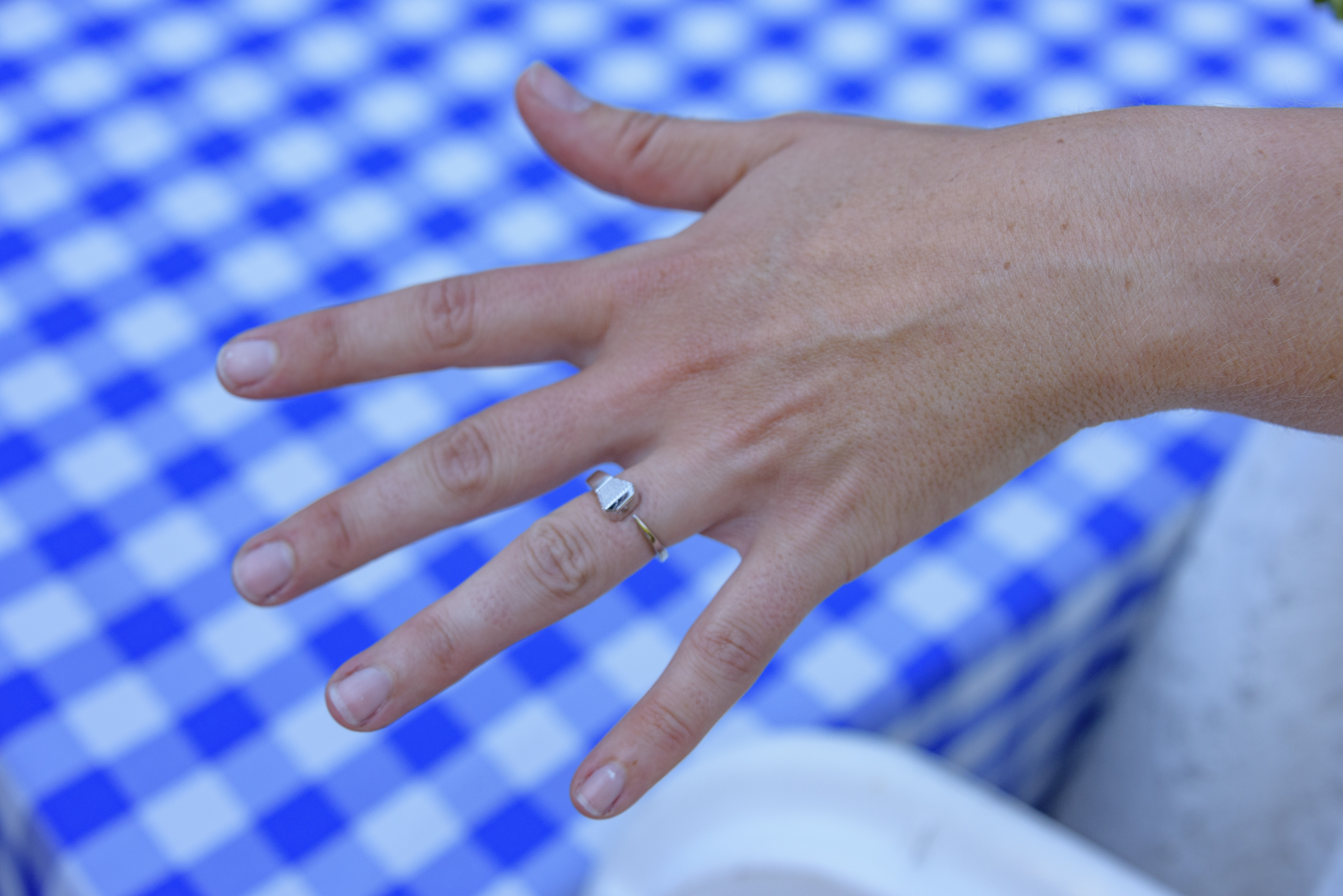It turns my finger the color of burnt orange peels when my hand gets damp. I paint the inside with clear nail polish to avoid this inevitability, but steel is not the best medium for jewelry. A horseshoe nail bent into the shape of a ring, this symbol of ‘prairie engagement’ was given to me by a 78-year old stranger. Over the course of a few shorts years, it has become my most prized possession.
The old man worked in a reenactment blacksmith shop at the Empire Mine in California. Jordan and I were visiting with my family for the annual Miner’s Picnic, described on their website as “an action-packed day of fun, food, gold history, and lasting memories.” Visitors are also advised that “a nail-biting mine rescue reenactment at high noon is a must.” Obviously we marked our calendars.
The reenactment was just as you would imagine. It began with a literal ‘bang’, then a group of dirty, moulage covered octogenarians emerged yelling from an old mining door. After 10 minutes of chaos (and let’s be honest, confusion), a retro fire truck came charging in to save the day. The reenactment complete, the actors high-fived in triumph and the audience applauded in appreciation.
The Blacksmith
We wandered into an old blacksmiths shop, or “smithy”, complete with red-hot forges and anvils. Inside, volunteers still make replica tools and devices the miners would have used, like horse-shoes (for mules), carts and wheels, candlestick holders, and nails. The shop is much the same as it would have been in 1925 when six blacksmiths worked 8-10 hours a day to serve the young-men working in the mine.
Next to one of the anvils, my would-be suitor was telling a story of the “courting candle”. When a man was courting a woman a hundred years ago, he would visit her porch to chat over candlelight while her father sat nearby. The candlestick was held in a spiraled, metal holder, with a nail driven into the wax from the side. When the top of the candle met the top of the metal spiral, it was lights out for the young lovers. If the father liked the lad, he could rotate the candle by spinning the nail up through the spiraled holder, thus making the candle longer and giving the suitor more time. If the father did not like the way things were going, he could rotate the candle in the opposite direction, bringing their time together to a speedy conclusion.
I was rapt with fascination hearing this tale of dating decorum from yesteryear. The blacksmith continued with a story of engagement.
As he told it, the work of blacksmiths was highly coveted in the mid-1800s. During the great western migration, the springtime would see massive swaths of people heading west to the land of opportunity. Often blacksmiths were not included in the wagon trains, so migrants purchased nails and other tools before crossing the Great Plains. Reaching the eastern edge of the Rockies in the fall, the families built rustic wooden homes to wait out the winter before crossing the mountains. The winter homes were burned to the ground as soon as the ground thawed, after which the women and children waded through the ashes, picking out every last nail for the journey ahead. According to lore, nails were so valuable that they were literally worth their weight in gold. That’s where we get the saying we still use today.
Inevitably, members from different wagon trains would socialize over the cold winters, and in some cases, fall in love. Because nails were the most valuable things around, these were bent into the shape of a ring and placed on a woman’s third finger as a symbol of engagement. From these humble beginnings, diamond rings were born.
As the blacksmith told us this story, he hammered a nail into the shape of a ring. Looking me directly in the eye, he asked for my hand and placed it on my finger. “Looks like it fits! Have a great day.” And that was it. I walked out with a new ring and a new (maybe?) fiancee.
Love at first sight
I loved the ring immediately. Not only because it was free (my penchant for being miserly is well documented) but because it held so much history. With a wide triangle at the tip tapering into a reasonably sharp end, it’s incredibly unique. So many people noticed and commented on the ring, and I loved the opportunity to share the prairie engagement story. I’m a sucker for history, and even more so when it involves love. Even though it really did turn my finger a gross shade of brown if I went too long without nail polishing it, I wore it every day for more nearly two years.
When Jordan and I started talking about getting married, I was only sure about one thing: I wanted my engagement/wedding ring to be modeled after the prairie ring. I hadn’t thought about where or how we should get married, or what kind of a dress I would wear, but the prairie ring was clear.
Once we decided on a surprise wedding in the backyard, he started the process of designing the ring, beautifully crafted by the team at Robbins Brothers. Slightly smaller and with a much greater sparkle factor, the platinum ‘nail’ took my breath away when Jordan proposed with it in our backyard. Six weeks later we were married in a surprise, western-themed ceremony befitting of the ring’s humble beginnings. A small momento from a fun family trip, the prairie ring has become the most meaningful piece of my own unique expression, today representing my past, present, and forever future.







Trackbacks/Pingbacks